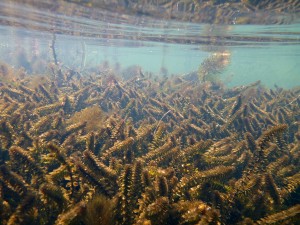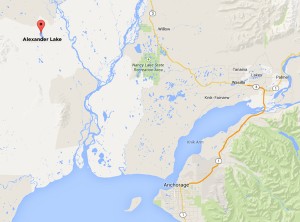Elodea, the waterway clogging invasive plant, has been identified for the first time in a Matanuska-Susitna Borough lake.
According to Brianne Blackburn, with the state Plant Materials Center in Palmer, the aquatic plant has been found in remote Alexander Lake, which is accessible only by floatplane or by boat. Blackburn says a team has been sent to the lake to determine the extent of the infestation.

“It’s a pretty good sized lake and its a relatively shallow lake, which means it has potentially a lot of available habitat for elodea, which is not necessarily a good thing, but we want to confirm where it is in a waterbody to identify how well established elodea is,” Blackburn said. “We want to get that done in the next couple of weeks so we can have that information over the winter to start looking at what we can do to manage it in that system.”
Blackburn says the discovery of elodea in Alexander Lake brings to 18 the number of Alaska waterways now infected with the plant.
Infestations have previously been discovered in Fairbanks, Cordova, Anchorage, and the Kenai Peninsula. In Cordova, the plant is found in eight waterbodies. Blackburn says boats easily transfer the pest from lake to lake. Fragments of the plant can hitchhike on boats, trailers or float planes to start new infestations. She says simple precautions can help to stem the plant’s spread – such as wiping down plane floats and boat trailers.

“And really the steps we have and the information we are putting out is really best management practices for people,” Blackburn said. “The majority of people using our lakes and streams and trails really want to protect those resources and see the benefit of taking those few extra steps.”
“It sometimes is not the most convenient activity to do after moving between waterbodies, but if people are aware of what they are looking for and those steps that they can take really is a good way to mitigate that risk between waterbodies.”
Elodea is a popular aquarium plant, and dumping of aquariums into waterbodies has been identified as one way that the plant spreads. It overtakes native plants and fills the water column with thick vegetative mats that can degrade fish habitat, foul boat propellers and floatplane rudders.
Efforts are underway to stop Elodea’s spread and control infestations throughout Alaska. Eradication efforts through herbicide treatment to three Kenai Peninsula lakes began in the spring of 2014. Multiple agencies in Fairbanks are exploring the feasibility of mechanical control in the Chena Slough, while other groups in Anchorage, Mat-Su, and Cordova are mapping out comprehensive management plans and surveying high-risk waterbodies.
APTI Reporter-Producer Ellen Lockyer started her radio career in the late 1980s, after a stint at bush Alaska weekly newspapers, the Copper Valley Views and the Cordova Times. When the Exxon Valdez ran aground in Prince William Sound, Valdez Public Radio station KCHU needed a reporter, and Ellen picked up the microphone.
Since then, she has literally traveled the length of the state, from Attu to Eagle and from Barrow to Juneau, covering Alaska stories on the ground for the AK show, Alaska News Nightly, the Alaska Morning News and for Anchorage public radio station, KSKA
elockyer (at) alaskapublic (dot) org | 907.550.8446 | About Ellen




